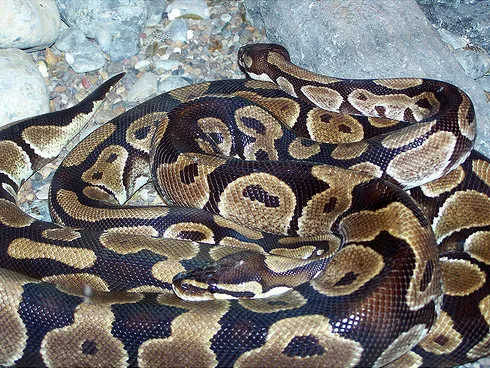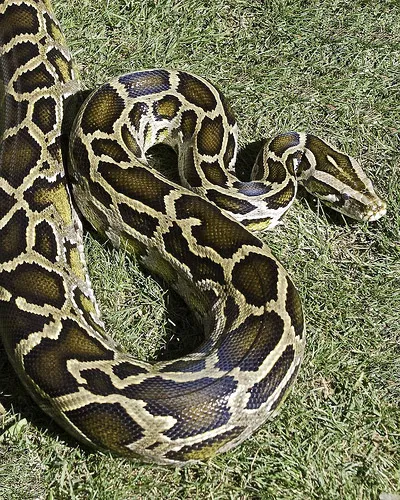Five Giant Snakes We Should Worry About
/https://tf-cmsv2-smithsonianmag-media.s3.amazonaws.com/filer/snake-boa-main.jpg)
Any report on invasive species is bound to have bad news, it seems, and a new report from the U.S. Geological Survey analyzing the threat from nine giant snake species is possibly even worse because we're talking about GIANT SNAKES (and I'm not generally scared of snakes). These snakes have already made their way here to the United States—as pets or hidden in cargo (Snakes on a Plane was NONFICTION?! -Ed.), usually—and pose a threat to the ecosystems where they might or have already become established. There are five identified as high risk (details below) and four medium risk species (reticulated python, DeSchauensee’s anaconda, green anaconda, and Beni anaconda). There are no low risks, the USGS notes, because all nine "share several traits that increase their risk of establishment, increase the damage they might do, or make eradication difficult." (Worryingly, the report notes that there are no control tools for eradicating these species once these have become established.)
Specifically, these snakes:
1. Grow rapidly to a large size (some individuals of these species surpass 20 feet in length and 200 pounds in weight);
2. Are habitat generalists (they can live in many kinds of habitats and have behaviors that allow them to escape freezing temperatures);
3. Are dietary generalists (can eat a variety of mammals, bird, and reptiles);
4. Are arboreal (tree-living) when young, which puts birds and arboreal mammals such as squirrels and bats at risk and provide another avenue for quick dispersal of the snakes;
5. Are tolerant of urbanization (can live in urban/suburban areas);
6. Are well-concealed “sit-and-wait” predators (difficult to detect, difficult to trap due to infrequent movements between hiding places);
7. Mature rapidly and produce many offspring (females can store sperm and fertilize their eggs—which in some of these snakes can number more than 100—when conditions are favorable for bearing young);
8. Achieve high population densities (greater impact on native wildlife); and
9. Serve as potential hosts for parasites and diseases of economic and human health significance. Had they not possessed these features, they might have constituted a low risk.
The five high risk species:
Burmese python (Python molurus) Native to: Southeast Asia, from Pakistan and India to China and Vietnam to Indonesia Size: on average, grows to 18 feet and 160 pounds Eats: terrestrial vertebrates, including lizards, birds and mammals; has been known to attack and kill humans U.S. states with suitable climate: Alabama, Arkansas, California, Florida, Georgia, Hawaii, Louisiana, Mississippi, Oklahoma, North Carolina, South Carolina, Texas Already established in: Florida, in the Everglades
Northern African python (Python sebae) Native to: central Africa from the coasts of Kenya and Tanzania to Mali and Mauritania, and north to Ethiopia and Eritrea; in arid regions, only near permanent water Size: a typical adult is around 16 feet Eats: antelopes, warthog, porcupine, caracal, birds, fish, crocodiles, lizards, frogs U.S. states with suitable climate: southern half of Florida, southern tip of Texas, Hawaii May already be established in: southern Florida
Southern African Python (Python natalensis) Native to: ranges from Kenya southwest to Angola and south through Namibia and eastern South Africa Size: a typical adult is around 16 feet, but can grow bigger than the Northern African python Eats: antelopes, warthog, porcupine, caracal, birds, fish, crocodiles, lizards, frogs U.S. states with suitable climate: southern half of Florida, along much of the southern border of Texas, Hawaii
Boa constrictor (Boa constrictor) Native to: much of central and South America, from Mexico to Argentina Size: adults are around 13 feet long Eats: mammals, birds, lizards, fish U.S. states with suitable climate: Arizona, Florida, Georgia, Hawaii, New Mexico, Texas Already established in: southern Florida
Yellow anaconda (Eunectes notaeus) Native to: Argentina, Bolivia, Brazil, Paraguay, Uruguay Size: 10 to 12 feet on average Eats: fish, turtles, aquatic birds, rodents U.S. states with suitable climate: Florida, southeast Georgia, southern and eastern Texas, southern California, Hawaii
Editor's Note: An earlier version of this article mistakenly identified the snakes in the photo as boa constrictors. They are ball pythons. The error has been fixed.
/https://tf-cmsv2-smithsonianmag-media.s3.amazonaws.com/accounts/headshot/Sarah-Zielinski-240.jpg)


/https://tf-cmsv2-smithsonianmag-media.s3.amazonaws.com/accounts/headshot/Sarah-Zielinski-240.jpg)